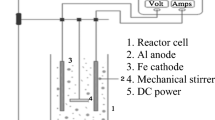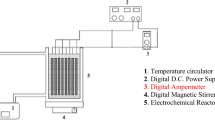Abstract
Phosphorus removal from wastewater is very important in order to prevent water eutrophication. Although there are many ways to remove phosphorus, electrocoagulation (EC) is a promising method. However, the efficiency of conventional EC processes needs to be further improved. In this study, magnetized iron particle anodes used for EC were fabricated and batch experiments were conducted. The results showed that magnetized anode configuration (iron powder, iron filings, iron sheet), current density (i), as well as electrolysis time had significant effects on phosphorus removal. Particle electrodes (e.g., iron powder) with both large specific surface area and high current density were beneficial for phosphorus removal. Simultaneously, anode magnetization could also enhance the phosphorus removal to some extent based on the effect of magnetic field (MF) on water characteristics (e.g., conductivity). Combining the advantages of particle electrode and MF, magnetized particle anode was superior to other electrodes in phosphorus removal and cell voltage maintenance. Compared with the conventional plate anode, the magnetized iron particle anode was more economical and could reduce operating cost by more than 50%. The results are useful for the practical application of phosphorus removal by EC.






Similar content being viewed by others
References
Ano, J., Assmian, A. S., Yobouet, Y. A., Adouby, K., & Drogui, P. (2019). Electrochemical removal of phosphate from synthetic effluent: a comparative study between iron and aluminum by using experimental design methodology. Process Safety and Environmental Protection, 129, 184–195.
APHA. (2005). Methods for the examination of water and wastewater (21st ed.). Washington, DC: American Public Health Association, American Water Works Association, Water Environment Federation.
Arambarri, J., Abbassi, B., & Zytner, P. (2019). Enhanced removal of phosphorus from wastewater using sequential electrocoagulation and chemical coagulation. Water, Air, & Soil Pollution, 230(12), 1–9.
Attour, A., Touati, M., Tlili, M., Ben, A. M., Lapicque, F., & Leclerc, J. P. (2014). Influence of operating parameters on phosphate removal from water by electrocoagulation using aluminum electrodes. Separation and Purification Technology, 123, 124–129.
Bassala, H. D., Dedzo, G. K., Njine Bememba, C. B., Tchekwagep Seumo, P. M., Dazie, J. D., Nanseu-Njiki, C. P., et al. (2017). Investigation of the efficient of a designed electrocoagulation reactor: application for dairy effluent treatment. Process Safety and Environmental Protection, 111, 122–127.
Bektas, N., Akbulut, H., Inan, H., & Dimoglo, A. (2004). Removal of phosphate from aqueous solutions by electro-coagulation. Journal of Hazardous Materials, 106(2–3), 101–105.
Chafi, M., Gourich, B., Essadki, A. H., Vial, C., & Fabregat, A. (2011). Comparison of electrocoagulation using iron and aluminium electrodes with chemical coagulation for the removal of a highly soluble acid dye. Desalination, 281, 285–292.
Chen, H., Feng, Y., Suo, N., Long, Y. Y., Li, X., Shi, Y. L., & Yu, Y. Z. (2019). Preparation of particle electrodes from manganese slag and its degradation performance for salicylic acid in the three-dimensional electrode reactor. Chemosphere, 216, 281–288.
De-Bashan, L. E., & Bashan, Y. (2004). Recent advances in removing phosphorus from wastewater and its future use as fertilizer (1997-2003). Water Research, 38(19), 4222–4246.
Gendel, Y., & Lahav, O. (2010). A new approach to increasing the efficiency of low-pH Fe-electrocoagulation applications. Journal of Hazardous Materials, 183(1–3), 596–601.
Gu, Z., Liao, Z. H., Schulz, M., Davis, J. R., Baygents, J. C., & Farrell, J. (2009). Estimating dosing rates and energy consumption for electrocoagulation using iron and aluminum electrodes. Industrial and Engineering Chemistry Research, 48(6), 3112–3117.
Guo, C. C., Liu, H. Y., Wang, C. Z., Zhao, J. C., Zhao, W. J., Lu, N., et al. (2020). Electrochemical removal of levofloxacin using conductive graphene/polyurethane particle electrodes in a three-dimensional reactor. Environmental Pollution, 260, 114101.
He, C. C., Hu, C. Y., & Lo, S. L. (2018). Integrating chloride addition and ultrasonic processing with electrocoagulation to remove passivation layers and enhance phosphate removal. Separation and Purification Technology, 201, 148–155.
Ibanez, J. G., Vazquez-Olavarrieta, J. L., Hernandez-Rivera, L., Garcia-Sanchez, M. A., & Garcia-Pintor, E. (2012). A novel combined electrochemical-magnetic method for water treatment. Water Science and Technology, 65(11), 2079–2083.
Kobya, M. A., & Demirbas, E. B. (2015). Evaluations of operating parameters on treatment of can manufacturing wastewater by electrocoagulation. Journal of Water Process Engineering, 8, 64–74.
Kong, W. P., Wang, B., Ma, H. Z., & Gu, L. (2006). Electrochemical treatment of anionic surfactants in synthetic wastewater with three-dimensional electrodes. Journal of Hazardous Materials, 137(3), 1532–1537.
Kumar, A., Nidheesh, P. V., & Suresh-Kumar, M. (2018). Composite wastewater treatment by aerated electrocoagulation and modified peroxi-coagulation processes. Chemosphere, 205, 587–593.
Lacasa, E., Cañizares, P., Sáez, C., Fernández, F. J., & Rodrigo, M. A. (2011). Electrochemical phosphates removal using iron and aluminium electrodes. Chemical Engineering Journal, 172(1), 137–143.
Liu, Y. C., Shi, H. C., Li, W. L., Hou, Y. L., & He, M. (2011). Inhibition of chemical dose in biological phosphorus and nitrogen removal in simultaneous chemical precipitation for phosphorus removal. Bioresource Technology, 102(5), 4008–4012.
Liu, Y., Yang, J., Jiang, W., Chen, Y., Yang, C., Wang, T., et al. (2018). Experimental studies on the enhanced performance of lightweight oil recovery using a combined electrocoagulation and magnetic field processes. Chemosphere, 205, 601–609.
Meng, S. L., Qiu, L. P., Chen, J. Z., & Xu, P. (2012). The research process of chemistry precipitation method in phosphorus removal in wastewater. Chinese Agricultural Science Bulletin, 28, 264–268.
Mishima, I., Hama, M., Tabata, Y., & Nakajima, J. (2018). Long term investigation of phosphorus removal by iron electrocoagulation in small-scale wastewater treatment plants. Water Science and Technology, 78(6), 1304–1311.
Mollah, M. Y.-A., Schennach, R., Parga, J. R., & Cocke, D. L. (2001). Electrocoagulation (EC)—science and application. Journal of Hazardous Materials, 84(1), 29–41.
Nawarkara, C. J., & Salkar, V. D. (2019). Solar powered electrocoagulation system for municipal wastewater treatment. Fuel, 237, 222–226.
Nepo-Hakizimana, J., Gourich, B., Chafi, M., Stiriba, Y., Vial, C., Drogui, P., et al. (2017). Electrocoagulation process in water treatment: a review of electrocoagulation modeling approaches. Desalination, 404, 1–21.
Nguyen, D. D., Ngo, H. H., Guo, W., Nguyen, T. T., Chang, S. W., Jang, A., et al. (2016). Can electrocoagulation process be an appropriate technology for phosphorus removal from municipal wastewater? Science of the Total Environment, 563-564, 549–556.
Omwene, P. I., Kobya, M., & Can, O. T. (2018). Phosphorus removal from domestic wastewater in electrocoagulation reactor using aluminium and iron plate hybrid anodes. Ecological Engineering, 123, 65–73.
Pi, K. W., Xiao, Q., Zhang, H. Q., Xia, M., & Gersonb, A. R. (2014). Decolorization of synthetic Methyl Orange wastewater by electrocoagulation with periodic reversal of electrodes and optimization by RSM. Process Safety and Environmental Protection, 92(6), 796–806.
Ramasahayam, S. K., Guzman, L., Gunawan, G., & Viswanathan, T. (2014). A comprehensive review of phosphorus removal technologies and processes. Journal of Macromolecular Science, Part A: Pure and Applied Chemistry, 51(6), 538–545.
Raschitor, A., Llanos, J., Caizares, P., & Rodrigo, M. A. (2020). Improved electrolysis of colloid-polluted wastes using ultrasounds and electrocoagulation. Separation and Purification Technology, 231, 115926.
Sahu, O., Mazumdar, B., & Chaudhari, P. K. (2014). Treatment of wastewater by electrocoagulation: a review. Environmental Science and Pollution Research International, 21(4), 2397–2413.
Sasson, M. B., Calmano, W., & Adin, A. (2009). Iron-oxidation processes in an electroflocculation (electrocoagulation) cell. Journal of Hazardous Materials, 171(1–3), 704–709.
Ugur, K., Talha, G. M., Fatih, I., & Kamil, V. (2008). Treatment of domestic wastewater by electrocoagulation in a cell with Fe-Fe electrodes. Environmental Engineering Science, 25(2), 153–162.
Vasudevan, S., Sozhan, G., Ravichandran, S., Jayaraj, J., Lakshm, J., & Sheela, S. M. (2008). Studies on the removal of phosphate from drinking water by electrocoagulation process. Industrial and Engineering Chemistry Research, 47(6), 2018–2023.
Wang, Y. M., Pugh, R. J., & Forssberg, E. (1994). The influence of inter-particle surface forces on the coagulation of weakly magnetic mineral ultrafine in a magnetic field. Colloids and Surfaces A-Physicochemical and Engneering Aspects, 90, 117–133.
Wang, Y. K., Wei, H. N., & Li, Z. W. (2018). Effect of magnetic field on the physical properties of water. Results in Physics, 8, 262–267.
Wei, L. Y., Guo, S. H., Yan, G. X., Chen, C. M., & Jiang, X. Y. (2010). Electrochemical pretreatment of heavy oil refinery wastewater using a three-dimensional electrode reactor. Electrochimica Acta, 55(28), 8615–8620.
Wu, Z. Y., Liu, Y., Wang, S. Y., Peng, P., Li, X. Y., Xu, J., et al. (2019). A novel integrated system of three-dimensional electrochemical reactors (3DERs) and three-dimensional biofilm electrode reactors (3DBERs) for coking wastewater treatment. Bioresource Technology, 284, 222–230.
Wysocka, I., & Masalski, W. (2018). A comparison between the electrocoagulation and the metal dissolution method in the process of phosphorus compounds removal from brewery wastewater. Environmental Progress & Sustainable Energy, 37(3), 975–979.
Wysocka, I., & Sokolowska, J. (2016). Comparison of two precipitation methods for the orthophosphate removal from wastewater. Desalination and Water Treatment, 57(41), 19171–19180.
Zaidi, N. S., Sohaili, J., Muda, K., & Sillanpää, M. (2014). Magnetic field application and its potential in water and wastewater treatment systems. Seperation and Purification Reviews, 43(3), 206–240.
Zhao, H. Z., Sun, Y., Xu, L. N., & Ni, J. R. (2010). Removal of Acid Orange 7 in simulated wastewater using a three-dimensional electrode reactor: removal mechanisms and dye degradation pathway. Chemosphere, 78(1), 46–51.
Zhou, M. H., Wang, W., & Chi, M. L. (2009). Enhancement on the simultaneous removal of nitrate and organic pollutants from groundwater by a three-dimensional bio-electrochemical reactor. Bioresource Technology, 100(20), 4662–4668.
Funding
This work was financially funded by the National Water Pollution Control and Treatment Science and Technology Major Project (2017ZX07202-004).
Author information
Authors and Affiliations
Corresponding author
Ethics declarations
Conflict of Interest
The authors declare that they have no conflict of interest.
Additional information
Publisher’s Note
Springer Nature remains neutral with regard to jurisdictional claims in published maps and institutional affiliations.
Rights and permissions
About this article
Cite this article
Zhang, X., Zhang, XQ., Yu, HB. et al. Phosphorus Removal from Wastewater by Electrocoagulation with Magnetized Iron Particle Anode. Water Air Soil Pollut 231, 502 (2020). https://doi.org/10.1007/s11270-020-04869-4
Received:
Accepted:
Published:
DOI: https://doi.org/10.1007/s11270-020-04869-4




